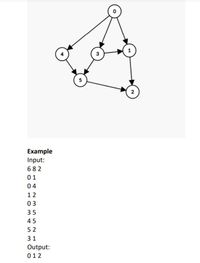
Concept explainers
C++
USE THE DRIVER CODE ATTACHED BELOW
// { Driver Code Starts
#include<bits/stdc++.h>
using namespace std;
// }Driver Code Ends
class Solution {
public:
// Function to return a path
// Enter your code here!
}
};
// { Driver Code Starts
int main() {
int tc;
cin >> tc;
while (tc--) {
int V, E, target;
cin >> V >> E >> target;
vector adj[V];
for (int i = 0; i < E; i++)
{ int u, v; cin >> u >> v;
adj[u].push_back(v);
// adj[v].push_back(u);
} // string s1;
// cin>>s1;
Solution obj;
vector ans = obj. shortestPath(V, adj, target);
for (int i = 0; i < ans.size(); i++) { cout << ans[i] << " "; } cout << endl; } return 0; } // } Driver Code Ends


Step by stepSolved in 2 steps with 1 images

- Complete the C++ code below#include "std_lib_facilities.h"/*1. Define a function which calculates the outer product of two vectors. The function return is a matrix. */vector<vector<int>> outerProduct(vector<int>& A, vector<int>& B){//implement here}/*2. Define a function which transposes a matrix. */vector<vector<int>> transpose(vector<vector<int>>& A){//implementation}/*3. Define a function which calculates the multiplication of a matrix and it's transpose. */vector<vector<int>> product(vector<vector<int>>& A){// implementation}/*4. Define a print out function that will print out a matrix in the following format:Example: a 3 by 4 matrix should have the print out:1 2 3 42 3 4 53 4 5 6*/void printMatrix(vector<vector<int>>& A){// implementation}int main(){// Define both vector A and vector Bvector<int> A = {1 ,2, 3, 4, 5};vector<int> B = {1, 2, 3};/*Test outerProduct…arrow_forwardimport java.lang.System; 3. public class FibonacciComparison { 4. // Fibonacci Sequence: 0, 1, 1, 2, 3, 5, 8 .... /* 7 input cases 8. 1) 0 9 2) 3 10 3) -1 11 4) 9 12 output cases 13 1) 0 14 2) 2 15 3) 0 16 4) 34 17 */ // Note that you need to return 0 if the input is negative. // Please pay close attention to the fact that the first index in our fib sequence is 0. 18 19 20 // Recursive Fibonacci public static int fib(int n) { // Code this func. 21 22 23 24 return -1; 25 26 // Iterative Fibonacci 27 28 public static int fiblinear(int n) { // Code this func. 29 30 return -1; 31 32 33 public static void main(String[] args) { 34 // list of fibonacci sequence numbers int[] nlist w { 5,10, 15, 20, 25, 30, 35, 40, 45}; 35 36 37 // Two arrays (one for fibLinear, other for fibRecursive) to store time for each run. // There are a total of nlist.length inputs that we will test double[] timingsEF = new double[nlist.Length]; double[] timingsLF = new double[nlist.length]; 38 39 40 41 42 // Every…arrow_forwardProgramming Languages Pragmatics, 4th Editionarrow_forward
- given code lab4 #include <stdio.h>#include <stdlib.h> /* typical C boolean set-up */#define TRUE 1#define FALSE 0 typedef struct StackStruct{int* darr; /* pointer to dynamic array */int size; /* amount of space allocated */int inUse; /* top of stack indicator - counts how many values are on the stack */} Stack; void init (Stack* s){s->size = 2;s->darr = (int*) malloc ( sizeof (int) * s->size );s->inUse = 0;} void push (Stack* s, int val){/* QUESTION 7 *//* check if enough space currently on stack and grow if needed */ /* add val onto stack */s->darr[s->inUse] = val;s->inUse = s->inUse + 1;} int isEmpty (Stack* s){if ( s->inUse == 0)return TRUE;elsereturn FALSE;} int top (Stack* s){return ( s->darr[s->inUse-1] );} /* QUESTION 9.1 */void pop (Stack* s){if (isEmpty(s) == FALSE)s->inUse = s->inUse - 1;} void reset (Stack* s){/* Question 10: how to make the stack empty? */ } int main (int argc, char** argv){Stack st1; init (&st1);…arrow_forwardData Structure Using C++ I need a function like this ::: float postfixEval(string postfix) {int a, b;stack<float> stk;string::iterator it;for(it=postfix.begin(); it!=postfix.end(); it++) {//read elements and perform postfix evaluationif(isOperator(*it) != -1) {a = stk.top();stk.pop();b = stk.top();stk.pop();stk.push(operation(a, b, *it));}else if(isOperand(*it) > 0) {stk.push(checkNumber(*it));}}return stk.top();} to evaluate postfix with more one digit in expression (multi digits) please just this function simple like the abovearrow_forwardProblem overview As you may already know from earlier courses, integer values in C++ (as well as other programming languages) are limited by the number of bits used to represent these data. For instance, a 64-bit unsigned integer has the maximum value of 2^64 - 1 or 18446744073709551615. One method of representing integers of arbitrary length, which was covered last spring, is a a linked list data structure such that that a node in the linked list corresponds to a single digit in the integer. For instance, the number 123 can be stored as linked-list that could look like this: [ 3 ] -> [ 2 ] -> [ 1 ] -> NULLNote that the first (or head) node in this list contains the least significant digit (in this case 3), while the last node contains the most significant digit (1). For this problem, you are to read in pairs of arbitrary length integers and produce correct output as outlined below. InspirationNote, this problem is inspired by Problem 8.19 from Elements of Programming…arrow_forward
 Database System ConceptsComputer ScienceISBN:9780078022159Author:Abraham Silberschatz Professor, Henry F. Korth, S. SudarshanPublisher:McGraw-Hill Education
Database System ConceptsComputer ScienceISBN:9780078022159Author:Abraham Silberschatz Professor, Henry F. Korth, S. SudarshanPublisher:McGraw-Hill Education Starting Out with Python (4th Edition)Computer ScienceISBN:9780134444321Author:Tony GaddisPublisher:PEARSON
Starting Out with Python (4th Edition)Computer ScienceISBN:9780134444321Author:Tony GaddisPublisher:PEARSON Digital Fundamentals (11th Edition)Computer ScienceISBN:9780132737968Author:Thomas L. FloydPublisher:PEARSON
Digital Fundamentals (11th Edition)Computer ScienceISBN:9780132737968Author:Thomas L. FloydPublisher:PEARSON C How to Program (8th Edition)Computer ScienceISBN:9780133976892Author:Paul J. Deitel, Harvey DeitelPublisher:PEARSON
C How to Program (8th Edition)Computer ScienceISBN:9780133976892Author:Paul J. Deitel, Harvey DeitelPublisher:PEARSON Database Systems: Design, Implementation, & Manag...Computer ScienceISBN:9781337627900Author:Carlos Coronel, Steven MorrisPublisher:Cengage Learning
Database Systems: Design, Implementation, & Manag...Computer ScienceISBN:9781337627900Author:Carlos Coronel, Steven MorrisPublisher:Cengage Learning Programmable Logic ControllersComputer ScienceISBN:9780073373843Author:Frank D. PetruzellaPublisher:McGraw-Hill Education
Programmable Logic ControllersComputer ScienceISBN:9780073373843Author:Frank D. PetruzellaPublisher:McGraw-Hill Education





